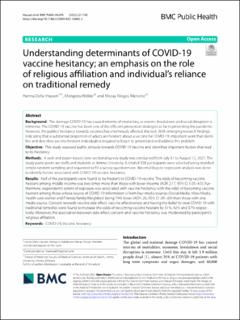| dc.contributor.author | Hassen, Hanna Defar | |
| dc.contributor.author | Welde, Mengistu | |
| dc.contributor.author | Menebo, Mesay Moges | |
| dc.date.accessioned | 2022-06-21T09:23:43Z | |
| dc.date.available | 2022-06-21T09:23:43Z | |
| dc.date.created | 2022-06-07T22:02:52Z | |
| dc.date.issued | 2022 | |
| dc.identifier.citation | Hassen, H. D., Welde, M. & Menebo, M. M. (2022). Understanding determinants of COVID-19 vaccine hesitancy; an emphasis on the role of religious affiliation and individual’s reliance on traditional remedy. BMC Public Health, 22, Artikkel 1142. | en_US |
| dc.identifier.issn | 1471-2458 | |
| dc.identifier.uri | https://hdl.handle.net/11250/2999767 | |
| dc.description.abstract | Background: The damage COVID-19 has caused interms of mortalities, economic breakdown and social disruption is immense. The COVID-19 vaccine has been one of the efficient prevention strategies so far in preventing the pandemic. However, the publics’ hesitancy towards vaccines has enormously affected this task. With emerging research findings indicating that a substantial proportion of adults are hesitant about a vaccine for COVID-19, important work that identifies and describes vaccine hesitant individuals is required to begin to understand and address this problem.
Objective: This study assessed public attitude towards COVID-19 Vaccine and identified important factors that lead to its hesitancy.
Methods: A web and paper-based cross-sectional survey study was conducted from July 31 to August 12, 2021. The study participants are staffs and students at Jimma University. A total of 358 participants were selected using stratified simple random sampling and requested to fill a survey questionnaire. Binomial logistic regression analysis was done to identify factors associated with COVID-19 vaccine hesitancy.
Results:Half of the participants were found to be hesitant to COVID-19 vaccine. The odds of becoming vaccine hesitant among middle income was two times more than those with lower income (AOR 2.17, 95% CI 1.05–4.5). Furthermore, respondent’s extent of exposure was associated with vaccine hesitancy with the odds of becoming vaccine hesitant among those whose source of COVID-19 information is from four media sources (Social Media, Mass Media, Health care worker and Friends/family/Neighbor) being 74% lower (AOR .26, 95% CI .09–.69) than those with one media source. Concern towards vaccine side effect, vaccine effectiveness and having the belief to treat COVID-19 with traditional remedies were found to increase the odds of becoming vaccine hesitant by 31%, 42% and 37% respectively. Moreover, the association between side-effect concern and vaccine hesitancy was moderated by participant’s religious affiliation. | en_US |
| dc.language.iso | eng | en_US |
| dc.rights | Navngivelse 4.0 Internasjonal | * |
| dc.rights.uri | http://creativecommons.org/licenses/by/4.0/deed.no | * |
| dc.title | Understanding determinants of COVID-19 vaccine hesitancy; an emphasis on the role of religious affiliation and individual’s reliance on traditional remedy | en_US |
| dc.type | Peer reviewed | en_US |
| dc.type | Journal article | en_US |
| dc.description.version | publishedVersion | en_US |
| dc.rights.holder | © The Author(s) 2022. | en_US |
| dc.source.volume | 22 | en_US |
| dc.source.journal | BMC Public Health | en_US |
| dc.identifier.doi | https://doi.org/10.1186/s12889-022-13485-2 | |
| dc.identifier.cristin | 2030096 | |
| dc.source.articlenumber | 1142 | en_US |
| cristin.ispublished | true | |
| cristin.fulltext | postprint | |
| cristin.qualitycode | 1 | |

